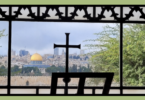Our spiritual ancestors (the Ancient Unitas Fratrum) organized a way of describing their core spiritual beliefs as the “essentials, ministerials, and incidentals.” I invite you to ponder why our tradition chose this mode of expression and its relevance for Moravian faith and practice today.
In part one, I noted that our spiritual ancestors organized this expression in three concentric circles. At the core are the essentials. Next are the critical resources that lead to experiencing and understanding the essentials (“the ministerials”). And finally, the features of church community life which form the outer circle (“the incidentals”). These three elements are not separate circles. They remain connected. Everything about the ministerials and incidentals are nested in the essentials. But what makes up the ministerials and incidentals are not essentials in themselves. It is the relationship with God in Jesus Christ that stands alone at the center as the essential.
Why choose this mode of expression? As stated in the Moravian Catechism: “The founders of the Ancient Unity had to explain why they rejected some teachings and practices of the Roman Catholic Church and did not reject others.” (“The Moravian Catechism” – IBOC: 2020, p. 6). By stating the “essentials” it also helped them explain why they could cooperate and collaborate with other Protestant communities while retaining their identity. “They believed that without the ‘essential’ things, a church cannot be a church, and if a church has these ‘essential’ beliefs, it is a church even if it has practices and principles that are different from other churches.” (p. 6) Believing and living out these “essentials” gives witness that we are followers of Jesus.
There are lots of directions one can go at this point to explore the “why” behind the way the “essentials” were organized. Just remember what remains at the center – a relationship with God through Jesus Christ (personally and corporately). See: The Theology of the Czech Brethren by Craig Atwood and Faith, Hope, Love, by Daniel Crews.
What stands out for me in the present moment is that this is all about relationship with God. Our ancestors did not attempt to quantify or qualify this with doctrinal statements, but with a road map for living into relationship with God and with fellow believers. God provides redeeming quality through God’s actions of creating, redeeming, and sustaining. On our part, we are called to respond with actions of faith, love, and hope in every decision we make (personally and collectively).
This map also gives us a clear guide for responding to God, life situations, and partnering with fellow followers of Christ in the work of reconciling the world to God (2 Corinthians 5:16-21). Our spiritual ancestors made a conscious choice not to build this around a system of doctrine or dogma, but around a faith expression that comes to life as we do it. There is also a built-in self-check: do my choices reflect agape-love, faith, and hope? If not, I have more work to do. And if my actions cause others to suffer, I must stop and choose a different way to act.
There is a context behind the uniqueness of this focus. It is more complex than I can describe here, but an important reference point for how our faith tradition began. It emerged out of a prolonged period of suffering caused by spiritual division, violence, and war. Following the execution of Jan Hus (1415) in the homelands of our ancestors, Moravia, Silesia, and Slovakia, there were 50 years of war and violence between Christians. Certain doctrines and dogma, as well as certain interpretations of scripture, were a source of bloodshed and division. As the Ancient Unitas Fratrum emerged in 1450s, this was a key reason the Bible and scriptural interpretation were not at the center among the “essentials” but was the first among the very necessary “minsiterials.” It was also why our ancestors stipulated that one’s view of theology or interpretation of scripture becomes “ineffective” at the point it causes others to suffer.
By 1618, the Ancient Unity was a significant Christian expression in Central Europe and Jan Amos Comenius had emerged as a key leader and Bishop. War broke out again, this time lasting 30 years and extending across mainland Europe. Once again war was waged between various expressions of the Christian faith. Our ancestors continued to focus the “essentials” on a relationship with God while avoiding the division and violence connected to systematic theologies and the debates they often inspired.
Another reason our ancestors held on to this simple road map for faith is that it was the centerpiece for how they organized congregations beginning in the 1400s. Their expression of the “essentials” was a literal focus point for daily prayer, study of scripture in small groups, and collective action. In the beginning, our ancestors lived in closed communities much like the Amish and Mennonites who came later. By the 1500s when they adapted to be open communities, they retained the emphasis on small groups. (More to come on this in the next issue).
They took to heart and mind the admonition to respond to all life situations with faith, love, and hope, and had a way to process it daily through small groups. As they did this, certain portions of scripture were elevated to the status of “the Gospel within the Gospel.” Whatever interpretation of scripture or discernment a small group or individual determined, it had to pass the test of the Sermon on the Mount (Matthew 5-7). If it was in-line with the statements of Christian faith and practice found in Matthew 5-7, it was a proper pathway; if it contradicted them, it was not a faithful path.
They gathered by small groups to do faith together, to experience God’s ongoing response and to seek ways to listen to God’s voice through the study of scripture, discerning together practical ways to give Christian witness, and to hold one another accountable. These actions pointed to love, faith, and hope without stirring up anger and hurt. The “essentials” served as the map for doing Christian life. For recognizing what makes for faithful Christian witness. Most importantly, for being reminded that our beliefs come to life as we actively engage in relationship with God and one another.
Stay tuned for more of the story in the next issue of the Provincial Ties.
Submitted by The Rev. Dr. Neil Routh, President, PEC







